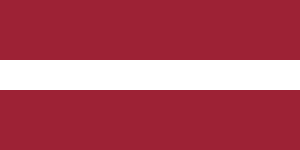
| Colors | HEX Code | RGB | CMYK |
|---|---|---|---|
| Red | #9D2235 | 157, 34, 53 | 0, 78, 66, 38 |
| White | #FFFFFF | 255, 255, 255 | 0, 0, 0, 0 |
The Latvian flag is bicolored with three unequal horizontal stripes. The upper and lower stripes are crimson red, while the middle stripe is thin and white. It separates the two crimson red stripes.
Meaning of the Latvian Flag
The red color represents the Latvians’ readiness to give blood from their hearts for freedom and to defend liberty. The white color represents the purity of the Latvians and peace.
History of the Latvian Flag
Latvia has long been occupied by European empires such as the Swedish and the Russian Empires. However, in the 19th century, the crimson red and white colors became popular among Latvians who were seeking to preserve their cultural identity through national symbols. The choice of the crimson red is rooted in the legends and myths of Latvia’s history. The red is said to represent the mulberry juice used to dye Latvian warriors’ garments. Another story said that a wounded soldier was carried in a white sheet, and the blood-stained sheet was used as a banner that led troops to victory. In 1918, Latvia proclaimed its independence and adopted its national flag. The flag was in use until 1940, when Latvia was again occupied by the Soviet Union. During soviet Rule, only the Soviet flags were raised, but the national flag of Latvia was forbidden to be hoisted. After the collapse of the Soviet Union in 1990, the Latvian flag was hoisted again and is still in use since independence in 1991.